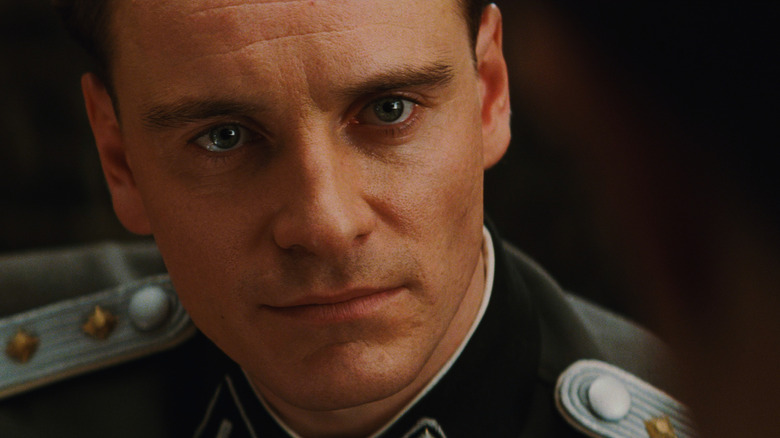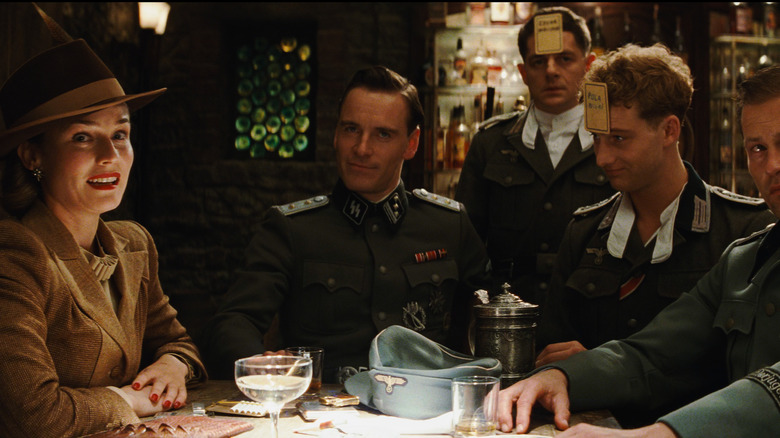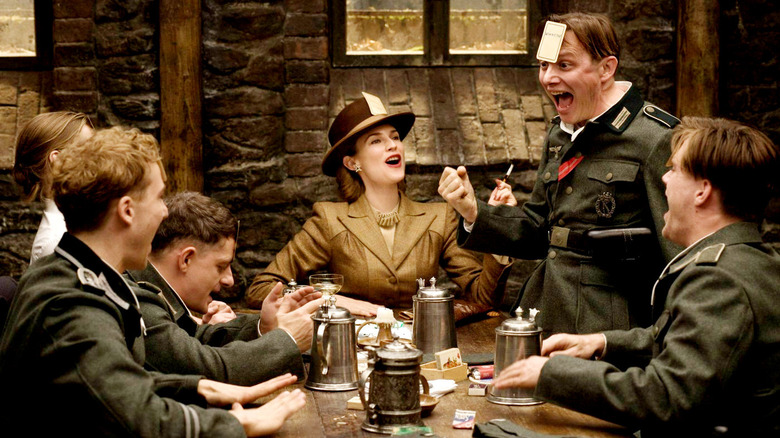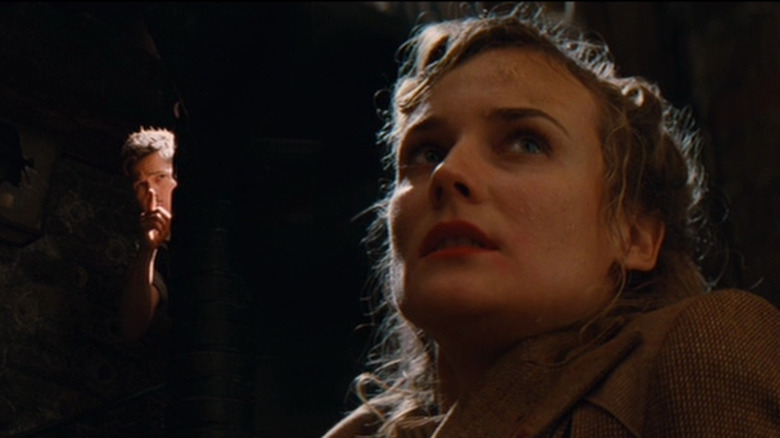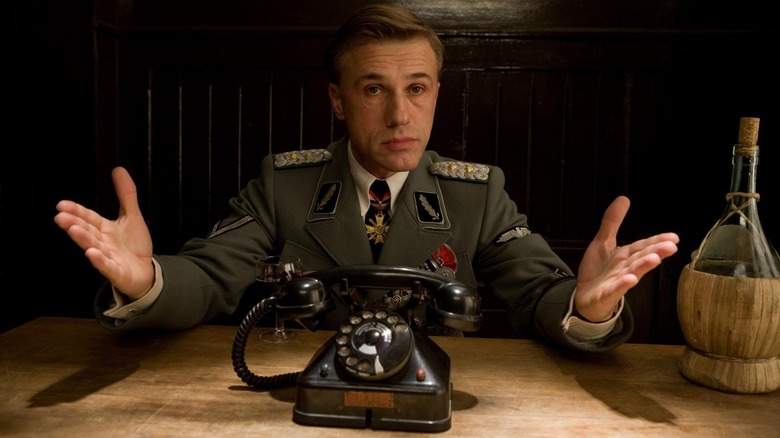Inglourious Basterds Borrowed Pieces From Four Previous Quentin Tarantino Films
Writer and director Quentin Tarantino is an avid film fan who famously pays homage to his favorite genre films in his own work, but for "Inglourious Basterds," he drew from his own filmography as well.
While "Basterds" is clearly inspired by numerous war films and Nazi exploitation movies like "Ilsa: She Wolf of the SS," Tarantino also loosely pulled from several of his previous films. In an interview with Rotten Tomatoes, Tarantino shared that he felt like "Inglourious Basterds" shared traits with his earlier films "True Romance," "Reservoir Dogs," and "Pulp Fiction." (Tarantino wrote the screenplay for "True Romance," which was directed by Tony Scott.) It's not surprising or unusual for a creative to draw from their earlier work, and Tarantino took some of the lessons learned from his past to make "Inglourious Basterds" the best it could be.
The director's sixth film is a tone-shifting historical drama that balances a tense war thriller with the ridiculous antics of the Nazi-fighting title characters, and the result is a hodge-podge of ideas, references, and genres that's pure Tarantino.
Multiple stories woven into one
When asked about "Inglourious Basterds" and its connections to Tarantino's previous work, the writer/director was candid about how he drew from his earlier films:
"The La Louisiane scene is like a reduced 'Reservoir Dogs,' but with Nazis and in German. It's a 23-minute scene, and instead of that warehouse they're in a little basement bar. But to me, there's this aspect that's like 'Pulp Fiction,' where you have all these different stories that are going in one direction. In this, it's more so. The stories are even more diverse, but it actually is telling one big story, as opposed to being a big mosaic. But it also kind reminds me of 'True Romance' a lot, because there's always a new character that comes in and takes the movie — someone who just takes the movie and runs with it. Every 20 minutes it's like, 'What the f*** movie is this?'"
Tarantino's early work was surprising to many film fans because of his tendency to weave multiple stories into one larger narrative. "Pulp Fiction," which he co-wrote with Roger Avary, weaves three different stories set in southern California into one movie, and tells them out of order. "Inglourious Basterds" is told in order, but the narratives shift between the work of the Basterds and the work of resistance fighter Shosanna (Mélanie Laurent) throughout the film. Similarly, "True Romance" is a wild story that introduces new characters constantly, and "Basterds" does the same. These inspirations have more to do with storytelling structure than the scenes themselves, but with the "Reservoir Dogs" inspiration, Tarantino drew a little deeper.
Trouble undercover
The La Louisiane scene that Tarantino's referring to follows German film star and spy for the Allies Bridget Von Hammersmark (Diane Kruger) and three Basterds operating undercover as Nazi officers: Lieutenant Archie Hicox (Michael Fassbender), Corporal Wilhelm Wicki (Gedeon Burkhard), and Sergeant Hugo Stiglitz (Til Schweiger). Stiglitz was a former German soldier who killed at least 13 Gestapo officers, while Archie was a British army officer aligned with the Nazi-scalping Basterds, led by Lietuenant Aldo Raine (Brad Pitt). Along with Wicki, one of the American army Basterds, Hicox and Stiglitz are to meet with Von Hammersmark in a basement bar, the La Louisiane, in order to work on their Hitler-killing plan, Operation Kino. When they get there, however, the place is absolutely crawling with Nazis out celebrating the birth of one soldier's son. The soldiers may be drunk and in good spirits, but there are other Nazis about, and they're paying closer attention to the undercover Basterds.
"Reservoir Dogs" is about a police officer (Tim Roth) working undercover during an armed bank robbery that goes horribly wrong. When everyone meets back at the rendezvous point (the aforementioned warehouse), they all try to figure out who among them is the mole. Just as Mr. White (Harvey Keitel), Mr. Blonde (Michael Madsen), and the rest of the characters in "Reservoir Dogs" try to discern who could have sold them out, the Nazi officers in "Inglourious Basterds" are doing their best to suss out the pretenders among them. It's nerve-wracking stuff (eventually Hicox blows their cover by using a British hand gesture), and it's a fun example of the director riffing on old ideas. What happens next, however, is a self-reference pulled straight from his ode to '70s exploitation, "Kill Bill."
A scene pulled directly from Kill Bill
After Hicox blows their cover and there's a wild firefight, only two people are left alive: Wilhelm (Alexander Fehling), the German soldier whose son was just born, and Bridget Von Hammersmark, who has been shot in the leg. When Lt. Raine descends the stairs and starts negotiating with Wilhelm, they find themselves locked in a stalemate. Raine and the Basterds can blow up the bar and Wilhelm, but they'll lose Von Hammersmark, and if Wilhelm shoots Raine, they're going to blow up the bar anyway. The two negotiate across the bar from one another, with Raine's face barely visible as he peeks around the bottom of the stairwell. Wilhelm starts begging for his life, explaining that his son Maximillian was just born, and the dialogue and framing mirrors a scene from "Kill Bill Volume 2" pretty directly.
In a flashback sequence during the second half of "Kill Bill," international assassin Beatrix Kiddo (Uma Thurman) discovers that she's pregnant after taking a pregnancy test in a hotel bathroom. Unfortunately, fellow assassin Karen Kim (Helen Kim) has her sights set on Kiddo, and she blasts a hole through the hotel room door with a shotgun. The two then have a very similar stand-off to the one between Wilhelm and Raine, as Kiddo tries to explain her delicate situation to Kim, her own gun locked on the would-be assassin. The framing is almost identical to that in "Inglourious Basterds," with low angles, faces framed in darkness, and quick cuts to each perspective. Some of the players have changed, but the situation is the same. Unlike "Kill Bill," where both parties survive, at least one of the people in the stand-off never makes it out of the basement.
Write what you know
There's an old writer's adage to "write what you know," and if there's one thing that Tarantino knows even better than the cinema of years past, it's his own contributions to film. The less-explicit recycling of themes and ideas from "Reservoir Dogs" and "Pulp Fiction" is no big deal, as many creatives repeat the same themes throughout their work. Tarantino would continue working with the idea of paranoia and undercover identities in "The Hateful Eight," and he would explore interwoven stories as one narrative again in "Once Upon a Time... In Hollywood," and it's possible he will continue to dig into them further in his final film (whatever that may end up being).
Thankfully, Tarantino never drew from the same well as directly as he did with "Kill Bill" and "Inglourious Basterds," but then again, maybe he did it just to be cheeky. After all, he's been paying homage to everyone else for so long, why not pay a little homage to himself?
